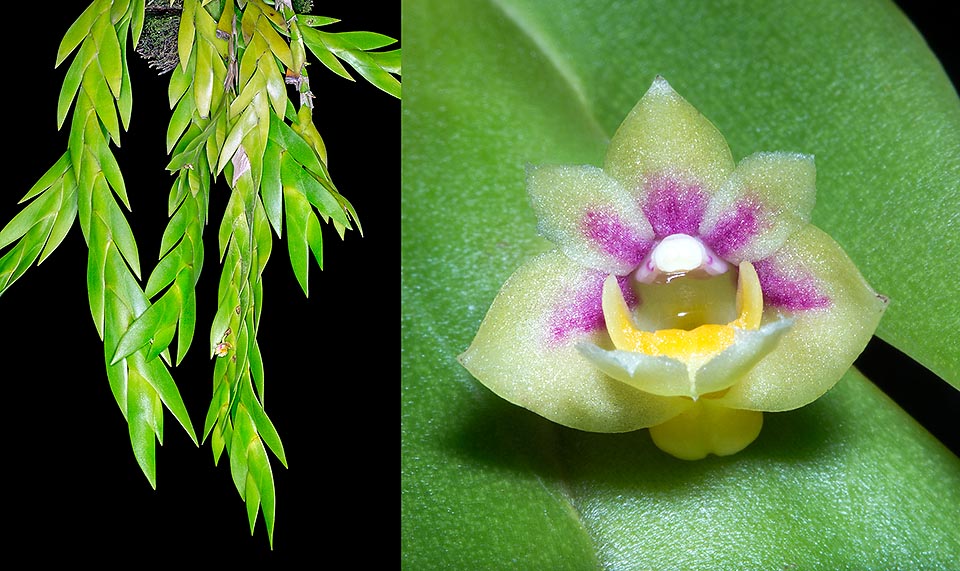Family : Orchidaceae

Text © Pietro Puccio

English translation by Mario Beltramini
The species is native to Andaman Islands, Borneo, Myanmar, Peninsular Malaysia, Singapore, Sumatra and Thailand where it lives in the evergreen humid forests at low and medium altitudes.
The name of the genus is the combination of the Greek substantives “δένδρον” (dendron) = tree and “βίος” (bios) = life, with reference to the numerous species of the genus living on the trees; the specific name is the Latin adjective “grandis, e” = big.
The Dendrobium grande Hook.f. (1890) is an epiphytic species with stems at times ramified, pendulous, flat, 15-50 cm long, and alternate leaves, distichous, imbricate, laterally flattened, lanceolate with pointed apex, 5-7 cm long and 1,5-2,5 cm broad with decreasing size towards the base and the apex. Inflorescences, on short peduncle, at the axil of the leaves with 1-2 flowers, of 1-1,2 cm of diameter, of yellowish colour with purple red spot at the base of the sepals and petals, that open from April to June. Ovate dorsal sepal with pointed apex, 5 mm long and 4 mm broad, ovate lateral sepals with pointed apex, 10 mm long and 6 mm broad, fused at the base of the column to form a sort of curved spur (mentum), ovate petals with pointed apex, 4 mm long and 2 mm broad, trilobed labellum, 10 mm long, with erect lateral lobes and median lobe, 7 mm broad, with deeply grooved apex.
It reproduces by seed, in vitro, and division, with each section provided of at least 3-4 pseudobulbs.

South-East Asian epiphyte, Dendrobium grande forms showy drooping tufts with flat stems, ramified at times, that reach 50 cm. Tiny 1-1,2 cm flowers © Giuseppe Mazza
Rather common orchid in some of the origin areas with the characteristic foliage and the tiny flowers that forms big drooping tufts, requires high luminosity, but not direct sun, medium-high temperatures, 20-30 °C, high humidity, 70-85%, and air constantly in movement. The waterings during the vegetative period must be regular and abundant, but allowing the substratum to dry up before giving water again, more spaced in winter until the vegetative restart. For the waterings and nebulizations is to be utilized rain water, demineralized or by reverse osmosis and for the fertilizations, monthly during the growth phase, can be employed hydrosoluble balanced fertilizers, with microelements, at half the dosage, or less, than what suggested by the producer. It can be cultivated on bark, trunks, rafts of cork or of arborescent ferns roots or in suspended pots or baskets with draining and aerated compost that can be formed by a mix of medium-sliced bark and charcoal or coir fragments. Divisions, transplants and repottings are to be done when strictly necessary upon the appearance of the new roots that mark the vegetative restart.
The species is reported in the appendix II of CITES (species whose trade is ruled internationally).
Synonyms: Callista grandis (Hook.f.) Kuntze (1891); Aporum grande (Hook.f.) Rauschert (1983).
→ For general notions about ORCHIDACEAE please click here.
